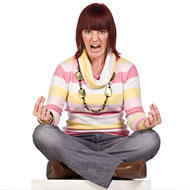Can yoga evoke feelings of rage in a person?
The practice of yoga is a trans-formative process, affecting a person on a mental, physical and emotional level. On an emotional level it can cause a lot of turbulence and many different feelings can keep surfacing. One such emotion is anger which may manifest itself in the form of a mild irritation, frustration and more extreme forms such as rage.
How does this happen? Why do these irrational feelings keep surfacing?
According to yogic theory, a human being has five bodies.
These are the physical body (annamaya kosha), the energetic body (pranayama kosha), the mental body (manomaya), the emotional body (vijnanamaya kosha) and the body of bliss (anandamaya kosha). The mental and emotional bodies are sometimes mistakenly referred to as the astral body.
Strong emotions such as anger can leave a pattern imprinted upon the astral body that lasts long after the original emotion has passed. These patterns cause us to react to situations in a preset manner, with similar thought patterns and feelings. They control our behavior and trap us, reducing our free will and preventing our true inner selves from emerging. Yoga can help us work through these patterns and become free of them.
How do the different yoga asanas free us of these destructive patterns?
During an asana, we stretch our bodies and remove blocks in our muscles and joints. Eventually, this frees the body and makes it healthier, but not before experiencing some pain as parts that were previously inflexible come unstuck.
At the same time, emotional and mental blocks within the astral body are also worked upon causing us to re-experience emotions and thoughts for no apparent reason. For example, you might be walking back home from a yoga class and feel angry and frustrated all of a sudden or maybe feel depressed some time later.
Yoga adepts say that specific asanas tend to be associated with specific feelings. For instance, hip opening poses can produce feelings of anger, frustration and depression while back bending poses can produce feelings of anger and paranoia and result in arousal. But this is not uniformly so and differs from person to person.
So what should one do when faced with this emotional turbulence?
The first step is to not react to and act out on these feelings. Try to observe the feelings and feel its presence within your body. Initially this may seem like a tall order, but it will become easier with practice. Observe your thoughts too and see if any specific memories are awakened. Are the feelings and thoughts directed at any particular person including you? Or are they just generalized?
Allow the feelings to flow. Try not to be judgmental by labeling the feelings as bad or unacceptable. For example, tell yourself “I am feeling angry and resentful and it is okay”. Observe the feelings as they flow.
Remember, these feelings will eventually pass. The period of emotional turbulence will pass and you will one day go back to being your former self. Maybe it will pass within a few days; maybe it will linger for a few months. Or maybe you won’t experience any kind of turmoil.
Most importantly, do not give up your yoga practices. Talk to your yoga instructor about the problems you are facing and follow his or her suggestions. After many months of practice you will feel a certain degree of lightness along with a sense of inner peace. The journey is well worth it.
Read more articles from the About Yoga Category.

 Find Pose
Find Pose

